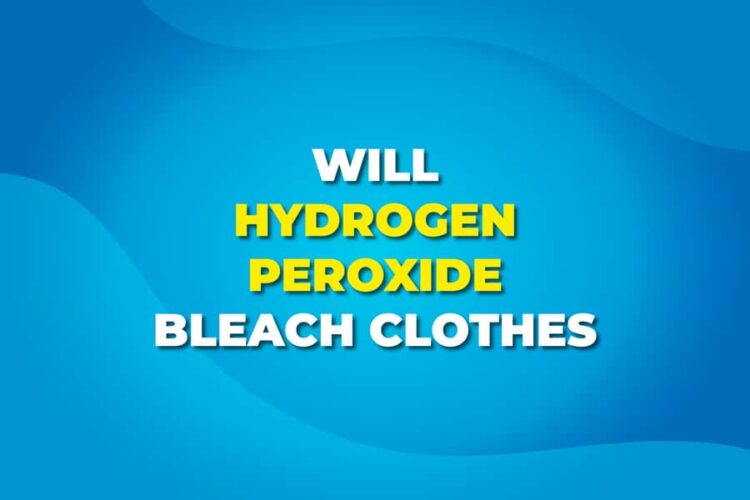In this blog, we are going to unravel the truth behind a common question that arises when it comes to laundry: Does hydrogen peroxide bleach clothes? We all want to keep our garments in top condition and avoid any unwanted surprises. That’s why it’s crucial to understand the impact of hydrogen peroxide on fabric. In this article, we will dive deep into the subject and separate fact from fiction. So, if you’ve ever wondered about the potential bleaching effects of hydrogen peroxide, you’re in for an informative read. Let’s explore the truth together and put any doubts to rest.
Will Hydrogen Peroxide Bleach Clothes?
Yes, hydrogen peroxide can bleach clothes. It is a powerful oxidizing agent commonly used for stain removal. When applied directly to fabric, it can lighten or remove color. However, it’s important to use it carefully and follow proper instructions to avoid damaging the fabric. Always test it on a small, inconspicuous area first.
Hydrogen Peroxide In Laundry: Effective Stain Removal And Fabric Compatibility
Hydrogen peroxide is a versatile chemical compound that is often used as a cleaning agent, antiseptic, and bleaching agent. When it comes to doing laundry, it can be an effective stain remover. However, it’s essential to consider its compatibility with different types of fabrics. Natural fabrics like cotton, linen, and wool generally handle hydrogen peroxide well, while synthetic fabrics such as polyester and nylon may be more prone to color fading or damage. Colored fabrics, including those made from natural materials, can also experience color loss when exposed to hydrogen peroxide.
To use hydrogen peroxide safely in your laundry routine, there are a few tips to keep in mind. First, dilute the hydrogen peroxide by mixing it with water. This helps reduce the concentration and minimizes the risk of fabric damage. Performing a patch test on a hidden area of the fabric is also recommended before treating the entire garment. This allows you to check for any adverse reactions or color fading. If the fabric remains unaffected after a few minutes, you can proceed with treating the stain.
Instead of applying hydrogen peroxide to the entire garment, it’s best to focus on the spot treatment. This means targeting specific stains or areas that require attention. Spot treatment minimizes the exposure of the fabric to hydrogen peroxide, reducing the chances of unwanted color fading or bleaching. After treating the stain, remember to rinse the fabric thoroughly with water to remove any residual hydrogen peroxide.
If you’re hesitant to use hydrogen peroxide or have fabrics that may not be compatible with it, there are alternative stain removal options available. Oxygen-based bleach, also known as color-safe bleach, is a suitable alternative that is gentle on fabrics while effectively removing stains. Natural stain removers like baking soda, lemon juice, or vinegar can also be effective in tackling various stains. These household ingredients have mild bleaching properties and are generally safe for most fabrics. However, it’s always a good idea to test them on a small area before applying them to the entire garment.
Hydrogen Peroxide And Fabric Compatibility
Natural Fabrics
Natural fabrics, such as cotton, linen, and wool, generally have good compatibility with hydrogen peroxide. These fabrics can withstand its bleaching effect without significant color loss or damage. However, it is still advisable to conduct a patch test on a hidden area before treating the entire garment.
Synthetic Fabrics
Synthetic fabrics, including polyester, nylon, and acrylic, are less compatible with hydrogen peroxide. These materials are more prone to color fading or damage when exposed to the strong oxidizing properties of hydrogen peroxide. It is crucial to exercise caution and avoid using hydrogen peroxide directly on synthetic fabrics.
Colored Fabrics
Colored fabrics are particularly vulnerable to the bleaching effect of hydrogen peroxide. Even natural fabrics with vibrant dyes can experience color fading when hydrogen peroxide is applied. It is best to avoid using hydrogen peroxide on colored garments to prevent unwanted discoloration.
Safe Usage Tips For Hydrogen Peroxide In Laundry
To ensure the best results and protect your clothing, here are some useful tips for using hydrogen peroxide in your laundry routine:
1. Dilute the hydrogen peroxide:
Before applying hydrogen peroxide to your clothes, dilute it with water. This helps reduce the concentration and minimize the risk of fabric damage or color fading. A safe and effective ratio is mixing one part hydrogen peroxide with three parts water.
2. Perform a patch test:
Always perform a patch test before treating an entire garment. Apply a small amount of the diluted hydrogen peroxide solution to an inconspicuous area of the fabric and observe any adverse reactions. If there is no color fading or damage after a few minutes, it is generally safe to proceed with treating the stain.
3. Focus on spot treatment:
Instead of applying hydrogen peroxide to the entire garment, it is best to focus on treating specific stains or areas that require attention. Spot treatment minimizes the exposure of the fabric to hydrogen peroxide, reducing the chances of unwanted color fading or bleaching.
4. Rinse thoroughly:
After treating the stain with hydrogen peroxide, make sure to rinse the fabric thoroughly with water. This helps remove any residual hydrogen peroxide and prevents potential damage or discoloration during the washing process.
5. Consider alternative options:
If you are hesitant to use hydrogen peroxide or have fabrics that may not be compatible with it, there are alternative stain removal options available. Oxygen-based bleach, also known as color-safe bleach, is a suitable alternative that is gentle on fabrics while effectively removing stains. Natural stain removers like baking soda, lemon juice, or vinegar can also be effective in tackling various stains and are generally safe for most fabrics. However, it is still advisable to test them on a small area before applying them to the entire garment.
Remember, following these safe usage tips will help you utilize hydrogen peroxide effectively while minimizing the risk of damage to your fabrics.
Alternative Stain Removal Options
If you are concerned about using hydrogen peroxide or have fabrics that are incompatible with it, there are alternative stain removal options available:
- Vinegar: Vinegar is a versatile and natural stain remover. Its acidic properties make it effective against many stains, including coffee, wine, and sweat. Simply dilute the vinegar with water and apply it directly to the stain before washing.
- Baking soda: Baking soda is another excellent alternative for stain removal. It works well on grease, oil, and food stains. Make a paste by mixing baking soda with water and gently rubbing it onto the stain. Let it sit for a while before washing.
- Lemon juice: Lemon juice acts as a natural bleaching agent and is particularly effective on stains like rust, ink, and mildew. Squeeze fresh lemon juice onto the stain, let it soak for a few minutes, and then wash as usual.
- Hydrogen peroxide: While it can bleach clothes, hydrogen peroxide is also a powerful stain remover. It works wonders on tough stains like blood, wine, and grass. Dilute it with water, apply it directly to the stain, and let it sit for a few minutes before laundering.
- Salt: Salt is a simple yet effective stain remover, especially for fresh stains like red wine or coffee spills. Blot the excess liquid, sprinkle salt on the stain, and let it absorb the moisture. Rinse with cold water and launder as usual.
Conclusion
Hydrogen peroxide can be a valuable tool for stain removal in your laundry routine. While it has excellent compatibility with natural fabrics, caution should be exercised when using it on synthetic fabrics or colored garments. Diluting hydrogen peroxide, performing patch tests, and spot-treating stains can help minimize the risk of fabric damage or color fading. Alternatively, you can explore oxygen-based bleach or natural stain removers as safer alternatives. By following these guidelines, you can effectively remove stains without compromising the quality and appearance of your clothes.







